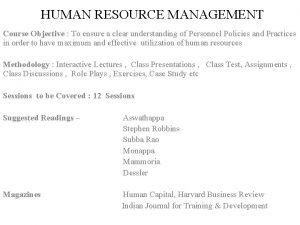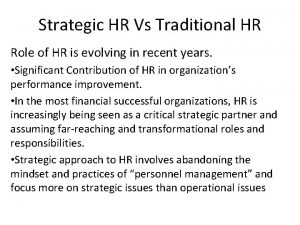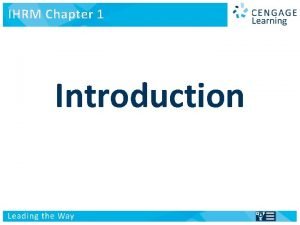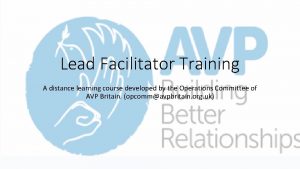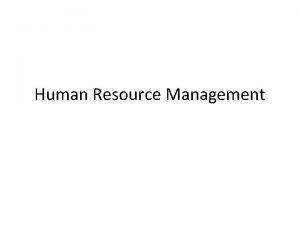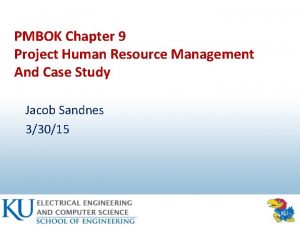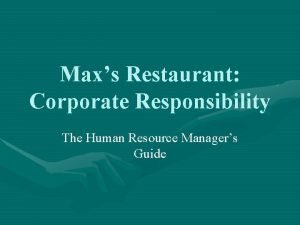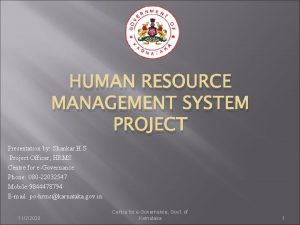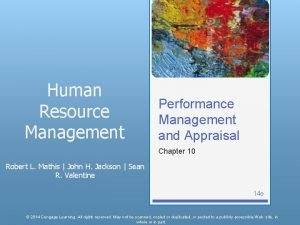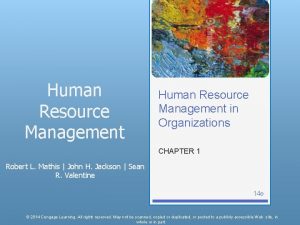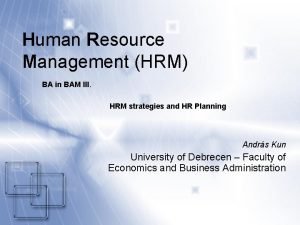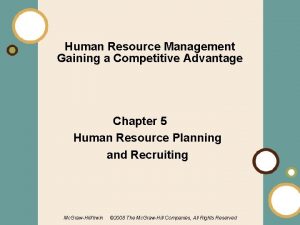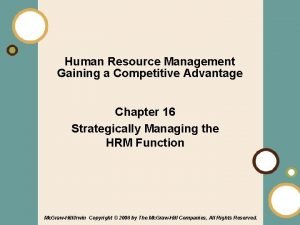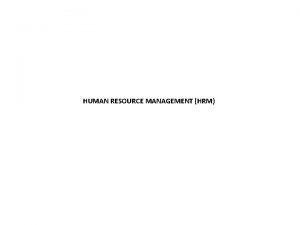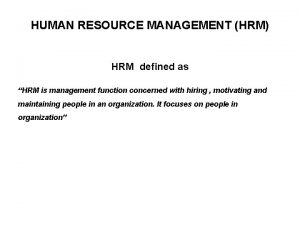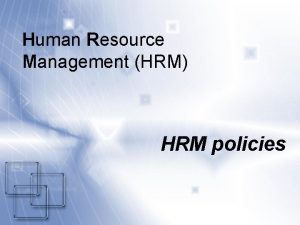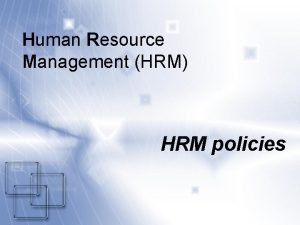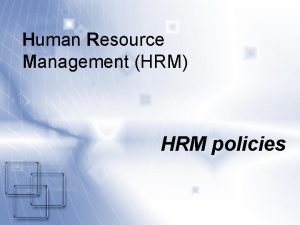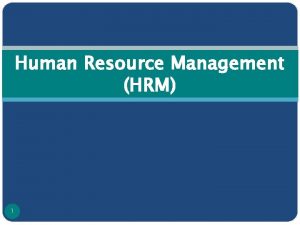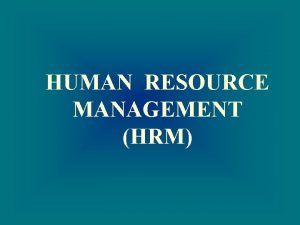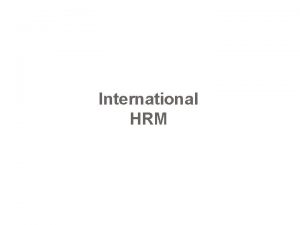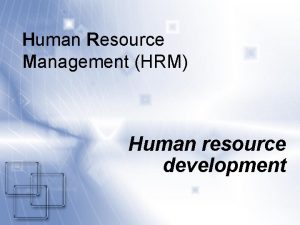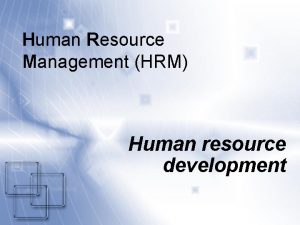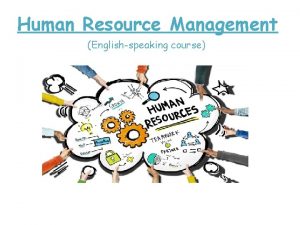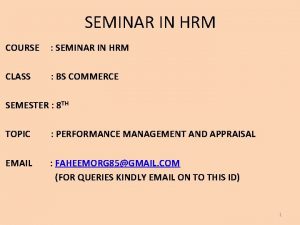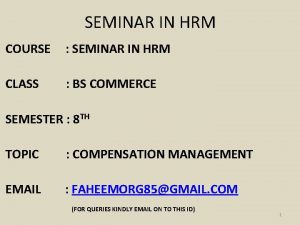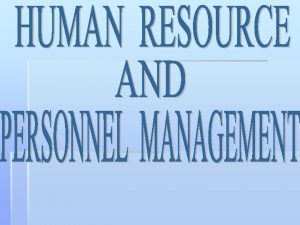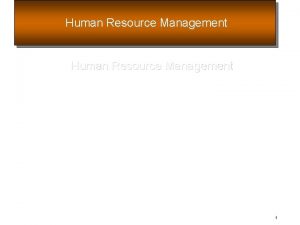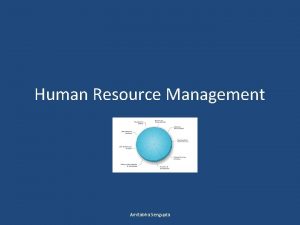Human Resource Management HRM 401 Course Facilitator Dr























- Slides: 23

Human Resource Management (HRM 401) Course Facilitator: Dr. Arzoo Atiq

Administrative Details • Course outline provided at: arzoo. atiq@wordpress. com • Navigate to Human Resource Management ; Password: iba-hrm • Lectures will be uploaded here. TA will transfer to LMS. • Office Hours: 2: 00 -2: 25 pm Assignments 4*3 = 12 -2 n-1 • Grading Scheme Participation Will be given during 5 (Bonus) Project sessions 2 * 5 = 10 Project Presentation 5 Two deliverables of five points each During Last week Mid-Term 15+15 = 30 Two Mid-Terms Final Exam 40

Questions? What do you think HRM is?

Human Resource Management • “HRM is management function concerned with hiring , motivating and maintaining people in an organization. It focuses on people in organization” (Aswathappa, 2008, p. 5) • The process of acquiring, training, appraising, and compensating employees, and of attending to their labor relations, health and safety, and fairness concerns. (Gary Dessler, 2013) • Strategic and coherent approach to the management of an organization’s most valued assest – the people working there who individually and collectively contribute to the achievement of its objectives. (Michael Armstrong, HRM Practice, 10 th ed. ) • ‘The process of analysing and managing an organisation’s human resource needs to ensure satisfaction of its strategic objectives’ (Hellriegel, Jackson, Slocum and Staude, 2009)

Basics • Organization • People with formally assigned roles who work together to achieve the organization’s goals. • Manager • The person responsible for accomplishing the organization’s goals, and who does so by managing the efforts of the organization’s people

The Management Process Planning Controlling Leading Gessler; Copyright © 2011 Pearson Education, Inc. publishing as Prentice Hall Organizing Staffing

Human Resource Management Processes Acquisition Training Fairness Health and Safety Labor Relations Gessler; Copyright © 2011 Pearson Education, Inc. publishing as Prentice Hall Human Resource Management (HRM) Appraisal Compensation

Scope Of HRM Prospects of HRM Career Development IR Employee Hiring HRM Employee Maintenance Source: Adapted from Aswathappa, 2008, p. 6 Employee Remuneration Employee Motivation

Historical Perspectives

Some historical perspective - Industrial Revolution: a. Adam Smith: specialization and division of labor. http: //www. whatishumanresource. com/adams-equity-theory (1963) b. Robert Owens: Pioneer of HRM, performance appraisal and pay for performance (fair treatment of employees) (1850) • Started in 19 th century, when some informed industrial companies in the US and Europe employed welfare officers to look after the wellbeing of workers, especially women and children. • In the 1920 s and 1930 s companies employed labour managers to handle pay, absence, recruitment and dismissal. • By the late 1940 s labour management and welfare work had been integrated under the banner of ‘personnel administration’. • As the importance of people to the success of firms was increasingly recognised throughout the 1970 s and 1980 s, personnel administration became ‘personnel management’ and eventually ‘human resource management’. • Today some companies refer simply to the ‘people’ function and call their most senior HR executive the ‘chief people officer’.

Scientific management Frederic Taylor: Father of scientific management https: //www. marxists. org/reference/subject/economics/taylor/principle s/ch 01. htm a. Definition: Systematic analysis and breakdown of work into the smallest mechanical components and rearranging them into the most efficient combination. b. Steps: Job analysis—selection—training—rewards.

Industrial psychology a. Hneri Fayol’s management functions: (1949) Planning, organizing, communicating, coordinating and controlling. b. F. & L. Gilbreth’s principles of work simplification (time and motion studies). (1890) c. Henry Gantt’s principles of work scheduling. (1915) d. Continuation of scientific management.

Human behavior and relations a. The Hawthorne Studies by Westing House The happy workers are the most productive workers. (The Pet Milk theory) (1960 s) b. Max Weber: the Ideal Bureaucracy. http: //www. hrmguide. co. uk/history/classical_organization_theory. htm c. Chris Argyris: Individual and organization—mutual adjustment. http: //infed. org/mobi/chris-argyris-theories-of-action-doubleloop-learning-and-organizational-learning/

Three stages of growth of HRM a. File Management (1900 -1964): collecting and storing data of each employee. b. Government Accountability (1964 -1980): Compliance to government regulations. c. Human Resource Management: • • Treating human resource as an asset. Emphasizing joint responsibilities of line managers and staff managers.

Questions?

Personnel Aspects of a Manager’s Job • • • Conducting job analyses Planning labor needs and recruiting job candidates Selecting job candidates Orienting and training new employees Managing wages and salaries Providing incentives and benefits Appraising performance Communicating Training and developing managers Building employee commitment Copyright © 2011 Pearson Education, Inc. publishing as Prentice Hall

Personnel Mistakes • Hire the wrong person for the job • Experience high turnover • Have your people not doing their best • Waste time with useless interviews • Have your firm in court because of discriminatory actions • Have your firm cited by regulatory authority for unsafe practices • Have some employees think their salaries are unfair and inequitable relative to others in the organization • Allow a lack of training to undermine your department’s effectiveness • Commit any unfair labor practices Copyright © 2011 Pearson Education, Inc. publishing as Prentice Hall

Basic HR Concepts • The bottom line of managing: Getting results • HR creates value by engaging in activities that produce the employee behaviors that the organization needs to achieve its strategic goals. • Looking ahead: Using evidence-based HRM to measure the value of HR activities in achieving those goals. Copyright © 2011 Pearson Education, Inc. publishing as Prentice Hall 1– 18

Line and Staff Aspects of HRM • Line Manager • Is authorized (has line authority) to direct the work of subordinates and is responsible for accomplishing the organization’s tasks. • Staff Manager • Assists and advises line managers. • Has functional authority to coordinate personnel activities and enforce organization policies. Copyright © 2011 Pearson Education, Inc. publishing as Prentice Hall

Line Managers’ HRM Responsibilities 1. Placing the right person on the right job 2. Starting new employees in the organization (orientation) 3. Training employees for jobs that are new to them 4. Improving the job performance of each person 5. Gaining creative cooperation and developing smooth working relationships 6. Interpreting the firm’s policies and procedures 7. Controlling labor costs 8. Developing the abilities of each person 9. Creating and maintaining department morale 10. Protecting employees’ health and physical condition Copyright © 2011 Pearson Education, Inc. publishing as Prentice Hall

Human Resource Managers’ Duties Functions of HR Managers Line Function Line Authority Implied Authority Copyright © 2011 Pearson Education, Inc. publishing as Prentice Hall Coordinative Functional Authority Staff Functions Staff Authority Innovator/Advocacy

Differences Between HRM and PM Dimensions 1. Employment contract HRM Aim to go behind contract 2. Rules PM Care full delineation of written contracts Importance of devising clear rules 3. Guide to management action Procedures Business need 4. Behaviour referent 5. Managerial task vis-à-vis labor Norms , customs and practices Monitoring Values and mission Nurturing 6. Speed of decision 7. Management role 8. Communication 9. Prized management skills Slow Transactional Indirect Negotiation Fast Transformational leadership Direct Facilitation 10. Selection 11. Labour management 12. Job categories and grade Separate , marginal task Collective barraging contracts Many Integrated, key task Individual contracts Few 13. Job design 14. Conflict handling Division of labour Reach temporary truce Team work Manage climate and culture Can do outlook, impatience with rule

Differences Between HRM and PM Dimensions PM HRM 15. Respect for employees Labour is used as tool which is spendable and replaceable Peoples are used as assets to be used for the benefit of organization 16. Shared interest Interest of organizations are uppermost Mutuality of interest 17. Evolution Precedes HRM Latest in evolution of subjects 18. Locus of control 19. Oganization principles External Mechanistic Top down centralized Internal Organic Bottom-up Decentralized 20. Key relations 21. Initiatives 22. Pay 23. Training and development Labour Management Piecemeal Job evaluation Controlled accessed to courses Customers Integrated Performance related Learning companies Source: Aswathappa, 2008, p. 7
 Human resource management course objectives
Human resource management course objectives Time management human resources
Time management human resources Human resource requirements of a retail organization
Human resource requirements of a retail organization Literal sense in hrm
Literal sense in hrm Traditional hr approach
Traditional hr approach Difference between domestic hrm and international hrm
Difference between domestic hrm and international hrm Facilitator course distance learning
Facilitator course distance learning Hrm course syllabus
Hrm course syllabus Project human resource management pmbok ppt
Project human resource management pmbok ppt Project human resource management pmbok
Project human resource management pmbok Importance of human resource management
Importance of human resource management Recruitment process of max's restaurant
Recruitment process of max's restaurant Human induction meaning
Human induction meaning Chapter 2 human resource management
Chapter 2 human resource management Chapter 9 human resource management
Chapter 9 human resource management Human resource management system project ppt
Human resource management system project ppt Performance appraisal in human resource management
Performance appraisal in human resource management Current issues in human resource management
Current issues in human resource management Ba human resource management
Ba human resource management Identify job vacancy
Identify job vacancy Human resources management gaining a competitive advantage
Human resources management gaining a competitive advantage Downsizing
Downsizing Human resource management gaining a competitive advantage
Human resource management gaining a competitive advantage Human resource management questions for exams
Human resource management questions for exams
